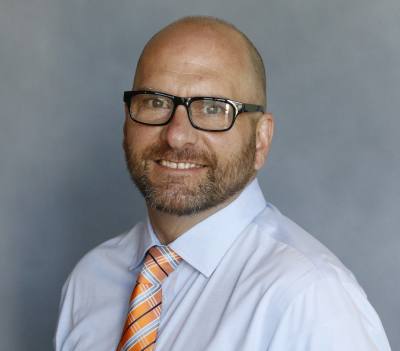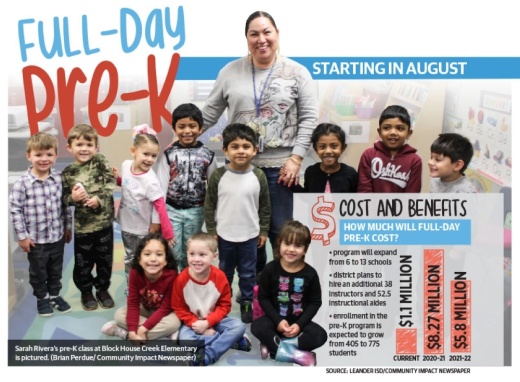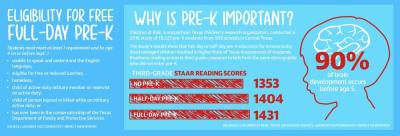Since Waller’s husband is a disabled veteran, Sebastian qualified for Leander ISD’s half-day pre-K program.Since 1985, LISD has offered a half-day, three-hour pre-K program to qualifying 4-year-olds. While many district families have the means to pay for early education through day care or private pre-K programs, children from certain demographics may lack early education opportunities, according to LISD, putting them at greater risk for future academic and behavioral hurdles.After three months in the pre-K program, Sebastian is “100% better,” according to Waller.
“Since he’s started school, he listens and has better social skills,” Waller said. “Ms. [Sarah] Rivera [Sebastian’s pre-K teacher] has helped him learn to control his emotions. I’m so grateful.”
In August, LISD will implement a state-mandated expansion from half-day to full-day pre-K education.
LISD officials said the switch to free, full-day pre-K will result in higher enrollment because it will be easier for working parents to enroll their children in a full-day program.
As a result, LISD is expanding its pre-K staff and campuses.
Of LISD’s 27 elementary schools, the pre-K program will expand from six to 13 campuses. Pre-K programs that offer bilingual instruction will also increase from three to four. LISD plans to hire an additional 38 instructors and 52.5 instructional aides by August.
There will also be a sizable increase in pre-K education costs—but LISD officials said local, state and national studies indicate pre-K education will save money for school districts in the long term.
Jennifer Freeman, LISD’s director of intervention services, said at-risk students that enter pre-K adjust better to K-12 instruction, score better on standardized testing and are less likely to require special education or other individualized instruction.
“We know that the research behind it tells us that pre-K helps students get a better start,” Freeman said. “They do better on their third-grade STAAR scores. Their kinder readiness is greater, which is a predictor for other things down the road.”
Pre-K education can also have a ripple effect into adulthood, according to Freeman and other LISD officials.
“There’s also societal paybacks,” she said. “You see reduced welfare expenses, reduced incarceration and things like that.”
Sarah Johnson, a pre-K teacher at Block House Creek Elementary School in Cedar Park, has instructed 4-year-olds for nearly nine years and has been a teacher for more than two decades.
“No question—pre-K helps the children so much in the long run,” she said. “It’s an investment.”
Big bumps in enrollment, cost
Heading into the April 14-15 pre-K registration for the 2020-21 school year, LISD officials estimate a sharp increase from the current enrollment of 405 students.
LISD predicts an enrollment surge to 775 students—a 91.36% increase—because the full-day format will be more accommodating to parents who work full-time.
“We only garner about 46% of the students who are eligible in our area right now,” Freeman said. “We feel like as we expand this and provide a full day, it’s going to allow more families to participate.”
The price for pre-K will also see a large increase. Using district, state and federal funding, LISD currently spends $1.1 million on half-day pre-K, according to the LISD business and financial services department. The first year of full-day pre-K is expected to cost the district $8.27 million.
LISD’s 2020-21 pre-K budget also includes “startup” funding to purchase additional buses, classroom furniture and supplies, according to Freeman.
District officials said the full-day pre-K cost will drop after the first year, once equipment is purchased for the expansion. The 2021-22 school year is expected to cost approximately $5.8 million, according to LISD.
House Bill 3, which became law in 2019 and mandated the switch to full-day pre-K, increased education funding in general and created a new early education allotment to help fund the expansion, according to the Texas Education Agency. LISD will also have to supply more funding for pre-K, according to Freeman.
“I’m excited about moving from half-day to full-day,” LISD board of trustees President Trish Bode said. “But it does require funds. The state provided some money, but it remains to be seen if it will be enough.”
Pre-K prepares students
To be eligible for LISD’s pre-K program, children must meet at least one of several factors, most of them socioeconomic. Children who fall into those criteria—from being an English as a second language child to qualifying for free or reduced-price lunches—are typically at a greater risk to encounter educational or behavioral challenges in their K-12 education, according to LISD.
Pre-K prepares those children for a school environment and reduces the risk of them facing certain challenges due to their background, according to Johnson.
“Our program is basically a world for 4-year-olds,” she said. “Because they have to qualify for the program through different means, our program attempts to give those children that maybe wouldn’t otherwise get the preparation to be successful [in kindergarten].”
Teachers use instruction disguised as play to instruct the children.
“We have worked so hard over the past five-plus years just developing our program. It’s play-based and high-quality. The kids are playing and learning at the same time,” Johnson said.
Johnson said a lot of the instruction works on the children’s social skills.
“We try to teach them how to get along with others, which is so important when they get to kindergarten,” she said.Freeman said some parents may not fully understand what is taught in pre-K, according to Freeman.
“There sometimes is a misconception in our community that this is a day care-type situation: ‘Why am I paying day care for other peoples’ children?’” she said. “Some think of it as an extension of kindergarten or first grade, but it really is a different environment for these kids.”
Another challenge has been the logistics of the expansion, according to Freeman.
“For us as a fast-growing district, it’s coming up with the room,” she said. “Transportation has been a challenge, too. We don’t want to overcrowd our schools, and we want our kids to have a great experience.”
The school day will provide two meals—breakfast and lunch—instead of one under the current format. A “rest time” for naps will be offered after lunch, as will a recess. Outdoor education will be a large part of full-day pre-K, according to Johnson.
One of the biggest changes for teachers will be having instructional aides in every classroom.
“That’s huge,” Johnson said.
After researching areas with the greatest need, 13 of LISD’s 27 elementary schools were selected to host full-day pre-K programs. However, a pre-K student in an elementary school’s zoning is not necessarily going to that school for pre-K, according to LISD.
“It’s likely it’s not going to be going along completely with our neighborhood zoning,” Freeman said.
The exact zones for pre-K will be provided during the April 14-15 registration dates, according to LISD.
“That’s our target to have everything mapped out,” Freeman said.
Pre-K 'the most important period'
LISD has tracked the performance of children in the district who enrolled in the district’s pre-K program with those who did not, even though they qualified.
“Our own studies have shown that those kids [who attend pre-K] have a lot less social-emotional situations,” Freeman said. “We see a reduction in services such as special education and things like that. “If we can get to those students early and start working with them at an early age, it really helps them with their trajectory going forward.”
A veteran teacher, Johnson calls early education “the most important period” of learning in a student’s educational journey. According to a 2007 study by the Harvard Center on the Developing Child, 90% of brain development occurs before age 5.“[Children who attend LISD pre-K] are just more successful in kinder and beyond,” Johnson said.









